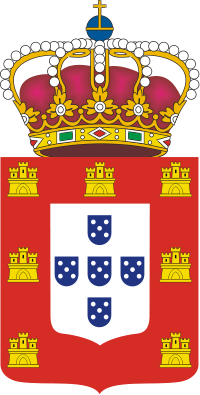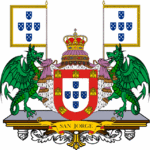- House of Braganza-Saxe-Coburg and Gotha
-
House of Braganza-Saxe-Coburg and Gotha 
Country Portugal Ancestral house House of Braganza Titles King of Portugal Founder Ferdinand II and Maria II Final sovereign Manuel II Current head Extinct Founding 9 April 1836 Deposition 5 October 1910 The House of Braganza-Saxe-Coburg and Gotha[1] (also known as the House of Braganza-Coburg)[2] was a branch of the House of Braganza that ruled the Kingdom of Portugal from 1853 until the declaration of the republic in 1910.
The use of the designation Braganza-Coburg, however, is prevalent mainly in the writings of non-Portuguese historians and genealogists, or in writings that are not contemporary to the rule of the Braganza-Saxe-Coburg and Gotha monarchs in Portugal. The reason for this is: the last four Kings of Portugal were descendants of Queen Maria II of Portugal, from the House of Braganza, and Prince Ferdinand of Saxe-Coburg and Gotha, and, technically, members of a cadet branch of the House of Wettin, by patrilineal descent. Nonetheless, they still continued to style themselves as members of the House of Braganza, as opposed to Braganza-Saxe-Coburg and Gotha.
Contents
History
The royal house was founded by Prince Ferdinand of Saxe-Coburg and Gotha who on 9 April 1836 married Queen Maria II of Portugal from the House of Braganza. Members of the royal house held the title Infante (or Infanta) of Portugal and Duke (or Duchess) of Saxony.[3] On 15 November 1853, Queen Maria II died, and her eldest son succeeded to the throne as Pedro V, the first king of the Braganza-Saxe-Coburg and Gotha dynasty.
The dynasty remained on the throne until the outbreak in Portugal of the 5 October 1910 revolution when King Manuel II was deposed and the Portuguese First Republic was established. Manuel II went into exile, and, with his death on 2 July 1932, the House of Braganza-Saxe-Coburg and Gotha became extinct.[1]
Before his death, Manuel II was reconciled with the rival Miguelist branch of the House of Braganza, who had claimed the Portuguese throne since 1834, in opposition to the Braganza-Saxe-Coburg and Gotha dynasty. So, with his death, the claim to the throne of Portugal passed to the pretender, Duarte Nuno, Duke of Braganza.[4][5]
Today, the descendants of Princess Theresa Christine of Saxe-Coburg and Gotha (1902–1990), who was a granddaughter of Princess Leopoldina of Brazil, carry the surname Tasso of Saxe-Coburg and Braganza (Portuguese: Tasso de Saxe-Coburgo e Bragança).[6] The Saxe-Coburg and Braganza surname was also used by Maria Pia de Saxe-Coburgo e Bragança, a woman who claimed to be a bastard daughter of King Carlos I.
Rulers
Family tree
Patrilineal descent
Descent before Conrad the Great is taken from fabpedigree.com and may be inaccurate.
House of Braganza-Saxe-Coburg and Gotha
- Burkhard I, Duke of Thuringia, d. 870
- Burchard, Duke of Thuringia, 836 - 908
- (possibly) Burkhard III of Grabfeldgau, 866 - 913
- Dedi I, Count in the Hessegau, 896 - 957
- (probably) Dietrich I, Count of Wettin, d. 976
- (possibly) Dedi II, Count in the Hessegau, 946 - 1009
- Dietrich II, Margrave of Lower Lusatia, 991 - 1034
- Thimo I, Count of Wettin, d. 1099
- (possibly) Thimo II the Brave, Count of Wettin, d. 1118
- Conrad, Margrave of Meissen, 1098–1157
- Otto II, Margrave of Meissen, 1125–1190
- Dietrich I, Margrave of Meissen, 1162–1221
- Henry III, Margrave of Meissen, c. 1215 - 1288
- Albert II, Margrave of Meissen, 1240–1314
- Frederick I, Margrave of Meissen, 1257–1323
- Frederick II, Margrave of Meissen, 1310–1349
- Frederick III, Landgrave of Thuringia, 1332–1381
- Frederick I, Elector of Saxony, 1370–1428
- Frederick II, Elector of Saxony, 1412–1464
- Ernest, Elector of Saxony, 1441–1486
- John, Elector of Saxony, 1468–1532
- John Frederick I, Elector of Saxony, 1503–1554
- Johann Wilhelm, Duke of Saxe-Weimar, 1530–1573
- John II, Duke of Saxe-Weimar, 1570–1605
- Ernest I, Duke of Saxe-Gotha, 1601–1675
- John Ernest IV, Duke of Saxe-Coburg-Saalfeld, 1658–1729
- Francis Josias, Duke of Saxe-Coburg-Saalfeld, 1697–1764
- Ernest Frederick, Duke of Saxe-Coburg-Saalfeld, 1724–1800
- Francis, Duke of Saxe-Coburg-Saalfeld, 1750–1806
- Prince Ferdinand of Saxe-Coburg and Gotha, 1785–1851
- Ferdinand II of Portugal, 1815–1885
- Luís I of Portugal, 1838–1889
- Carlos I of Portugal, 1863–1908
- Manuel II of Portugal, 1889–1932
References
- ^ a b Almanach de Gotha (175th ed.). Justus Perthes. 1938. p. 112.
- ^ Maclagan, Michael (2002). Lines of Succession. Tables by Jiri Louda. Time Warner Books. p. 187. ISBN 0316724289.
- ^ Almanach de Gotha (146th ed.). Justus Perthes. 1909. p. 66.
- ^ "Monarchist Breach Closed In Portugal". The New York Times: p. N1. 1930-05-18.
- ^ "Successor Expects Throne". The New York Times: p. 19. 1932-07-06.
- ^ McNaughton, Arnold (1973). The Book of Kings: A Royal Genealogy. Garnstone Press. p. 368.
External links
House of Braganza-Saxe-Coburg and GothaCadet branch of the House of Saxe-Coburg and GothaPreceded by
House of Braganza
Ruling House of the Kingdom of Portugal
1853–1910Republic Established by Military Coup 1st generation 
2nd generation Carlos I · Afonso3rd generation Categories:- House of Braganza-Saxe-Coburg and Gotha
- European royal families
- History of Portugal
Wikimedia Foundation. 2010.
